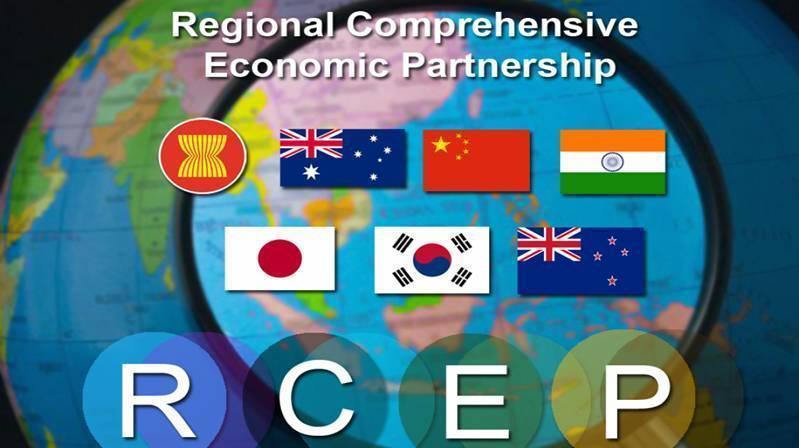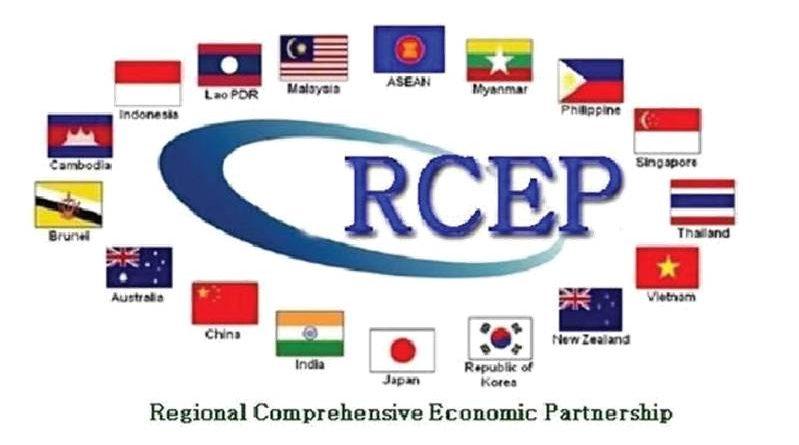World’s biggest trade deal, the Regional Comprehensive Economic Partnership (RCEP), takes effect as boost for global economy
The world’s largest free trade pact, the Regional Comprehensive Economic Partnership (RCEP) agreement, entered into force Saturday to provide a tailwind for the region’s post-pandemic recovery and a catalyst for global economic progress, bringing a ray of hope.
— Given its size and terms, the RCEP is widely expected to bolster regional trade and investment flows, and boost economic integration and prosperity in the region and beyond.
— At a time when the benefits of free trade and globalization are being questioned, the RCEP’s rollout marks “a victory for multilateralism and free trade.”
The world’s largest free trade pact forged by 15 Asia-Pacific countries entered into force Saturday to provide a tailwind for the region’s post-pandemic recovery and a catalyst for global economic progress, bringing a ray of hope.
The Regional Comprehensive Economic Partnership (RCEP) agreement groups 10 Association of Southeast Asian Nations (ASEAN) countries, as well as China, Japan, South Korea, Australia, and New Zealand, covering nearly a third of the world’s population and gross domestic product.
Given its size and terms, the RCEP is widely expected to bolster regional trade and investment flows, and boost economic integration and prosperity in the region and beyond.
The Regional Comprehensive Economic Partnership (RCEP) is a free trade agreement among the Asia-Pacific nations of Australia, Brunei, Cambodia, China, Indonesia, Japan, South Korea, Laos, Malaysia, Myanmar, New Zealand, the Philippines, Singapore, Thailand, and Vietnam.The 15 member countries account for about 30% of the world’s population (2.2 billion people) and 30% of global GDP ($26.2 trillion), making it the largest trade bloc in history. It is the first free trade agreement among the East Asian countries of China, Japan, and South Korea, three of the four largest economies in Asia.As of 3 December 2021, six of the ten ASEAN and all five of the non-ASEAN signatories have deposited their instruments of RCEP ratification with the Secretary-General of ASEAN. The trade pact took effect on 1 January 2022 for most members.
BOON FOR REGIONAL TRADE, INVESTMENT
“The golden age of durian trade is coming,” said Edwyn Chiang, secretary general of the Malaysia International Durian Industry Development Association, expecting the RCEP to spur exports of the thorny “king of fruits” by 50 percent by the year 2030.

The RCEP will open up a broader market and development space for Malaysia’s agriculture sector, strengthen the country’s agricultural product trade as well as the sector’s investment and cooperation with other member countries, Chiang said.
“This (RCEP) will not only present new opportunities for Malaysian businesses, but also for regional business communities tapping into RCEP to access Malaysian and ASEAN markets more broadly,” Malaysian Prime Minister Ismail Sabri Yaakob said.
The free trade bloc is expected to eventually eliminate tariffs on more than 90 percent of goods, expand market access for investment, harmonize rules and regulations, streamline customs procedures, and set common rules concerning the development of e-commerce as well as small and medium-sized enterprises, according to business insiders.
A gantry crane loads containers onto a freight train in Nanning international railway port in south China’s Guangxi Zhuang Autonomous Region, Dec. 31, 2021. (Xinhua)
ASEAN Secretary-General Dato Lim Jock Hoi said the pact will “open up opportunities that could catalyze the expansion of regional trade and investment.”
“Under the RCEP agreement, the region will become a single production base as well as a market for its products,” he said.
The United Nations Conference on Trade and Development said the RCEP will create “a center of gravity for global trade,” expecting the agreement’s tariff concessions to boost exports within the region by 42 billion U.S. dollars.
Businesses with global supply chains might face tariffs even within a free trade area (FTA) if their products contain components that are made elsewhere. Under the RCEP’s rules of origin, parts from any member country would be treated equally, which might give companies in RCEP countries an incentive to look within the region for suppliers, analysts said.
The RCEP’s tariff concessions, unified rules of origin and simplification of customs procedures “will enable our company to purchase raw materials and equipment as well as distribution of products more efficiently and at a lower cost,” said Qiu Jinliang, managing director of Himile (Thailand) Co., a tire mold supplier.
Li Yanqiang, chairman of Beibu Gulf Port Group in south China’s Guangxi Zhuang Autonomous Region, expected the RCEP to promote economic and trade cooperation within the region and increase the port’s container throughput.
Of the 44 shipping routes linking the port with overseas ports, 28 are connected to RCEP countries, Li said.
By 2030, the RCEP will increase the member economies’ incomes by 0.6 percent, adding 245 billion dollars annually and 2.8 million jobs to the regional economy, according to a study by the Asian Development Bank.
“A SHOT IN THE ARM” FOR GLOBAL ECONOMY
The RCEP came into force initially in 10 countries that have submitted instruments of ratification with the ASEAN Secretariat.
The Regional Comprehensive Economic Partnership (RCEP) agreement, the world’s largest trade deal so far, enters into force on Jan. 1, 2022. (Xinhua/Xu Qin)
As global economic recovery still moves in fits and starts, the RCEP’s entry into force would definitely be “a shot in the arm” for the world economic and trade development, said Ge Hongliang, deputy director with the College of ASEAN Studies at the Guangxi University for Nationalities.
“It will help sustain the global economic recovery and mitigate the adverse impacts of the pandemic,” Ge said.
In the latest World Economic Outlook report, the International Monetary Fund (IMF) trimmed its 2021 global growth forecast to 5.9 percent from a 6-percent forecast made in July. It kept a 2022 global growth forecast unchanged at 4.9 percent.
“This modest headline revision, however, masks large downgrades for some countries,” the IMF said in the report, adding that the worsening pandemic dynamics have darkened the outlook for low-income developing countries while advanced economies are struggling with supply disruptions.
The increase of regional trade through the RCEP will restore some economic activities shut down or slowed down by the pandemic, said William Jones, Washington bureau chief of the U.S. publication Executive Intelligence Review.
“The increase in the ‘flow’ of goods and services enabled by the digital economy also leads to increased economic growth,” Jones said, expecting an e-commerce boost through the RCEP to lift growth.
The RCEP facilitates deeper integration of supply chains, while the flexibility and mobility in the flow of goods and services will create an Asia-Pacific super supply chain that can address supply disruptions caused by the pandemic, said Lawrence Loh, a professor at the National University of Singapore’s Business School.
VICTORY FOR MULTILATERALISM, FREE TRADE
At a time when the benefits of free trade and globalization are being questioned, the RCEP’s rollout marks “a victory for multilateralism and free trade.”
The RCEP’s entry into force is a manifestation of the region’s resolve to support an open, free, fair, inclusive, and rules-based multilateral trading system, the ASEAN Secretariat said in a statement on Saturday.
Staff members unload cargos from a plane at the Phnom Penh International Airport in Phnom Penh, Cambodia, Dec. 31, 2021. (Photo by Van Pov/Xinhua)
Considering the RCEP as a model for other FTAs to emulate, Loh said although the RCEP is pan-regional in nature, there are opportunities to collaborate with other FTAs in the Americas and Europe.
“RCEP’s linkages in trade and investment will serve to strengthen globalization, which is currently being threatened by geopolitical tensions,” Loh said.
Liu Ziyang, a professor at Kyonggi University in South Korea, said the implementation of the RCEP will accelerate negotiations on the trilateral free trade agreement among China, Japan and South Korea, and speed up the building of the FTA of the Asia-Pacific.
Besides an economic growth stimulus effect, Jin Jianmin, a senior fellow at the Fujitsu Research Institute in Japan, expected the RCEP to improve institutional reforms and global economic governance capabilities, which will help promote medium- to long-term sustainable development. (Video reporters: Wang Yaguang, Guo Xinhui, Deng Min, Du Yuming, Hao Yalin, Qi Xing, Yang Chi, Wu Changwei, Yang Yunqi, Lu Huaiqian, Lu Haiyue, Liang Huiwen, Ta Na, Wan Po, Zhu Wei; video editors: Zhang Qiru, Zhang Yuhong, Hong Yan)■




